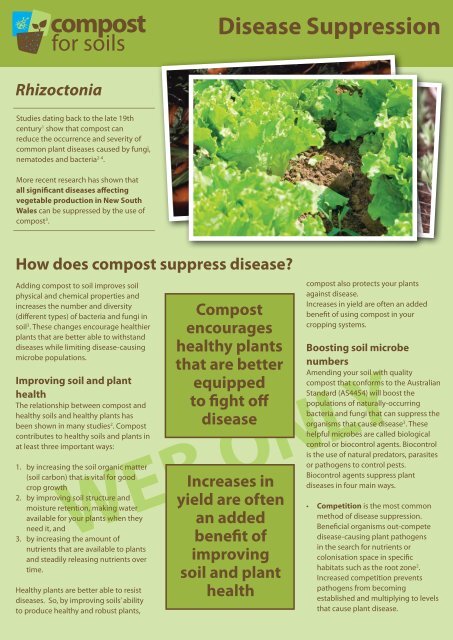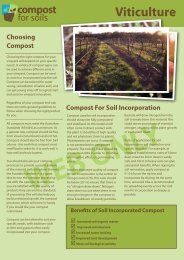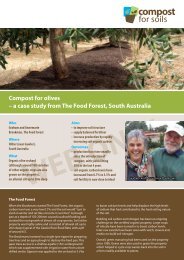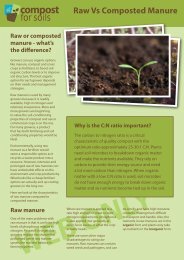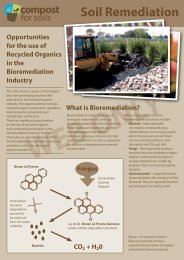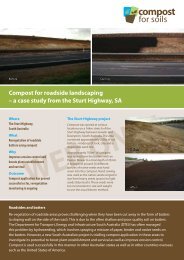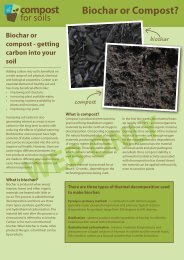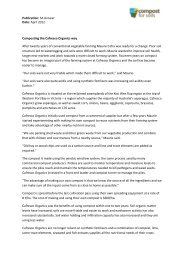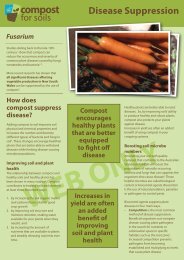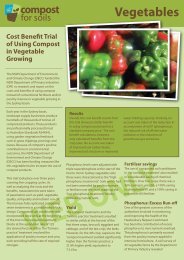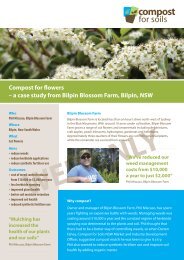Rhizoctonia - Compost for Soils
Rhizoctonia - Compost for Soils
Rhizoctonia - Compost for Soils
You also want an ePaper? Increase the reach of your titles
YUMPU automatically turns print PDFs into web optimized ePapers that Google loves.
ocompost <strong>for</strong> soilsDisease Suppression<strong>Rhizoctonia</strong>Studies dating back to the late 19thcentury 1 show that compost canreduce the occurrence and severity ofcommon plant diseases caused by fungi,nematodes and bacteria 2-4 .More recent research has shown thatall significant diseases affectingvegetable production in New SouthWales can be suppressed by the use ofcompost 3 .How does compost suppress disease?Adding compost to soil improves soilphysical and chemical properties andincreases the number and diversity(different types) of bacteria and fungi insoil 3 . These changes encourage healthierplants that are better able to withstanddiseases while limiting disease-causingmicrobe populations.Improving soil and planthealthThe relationship between compost andhealthy soils and healthy plants hasbeen shown in many studies 2 . <strong>Compost</strong>contributes to healthy soils and plants inat least three important ways:1. by increasing the soil organic matter(soil carbon) that is vital <strong>for</strong> goodcrop growth2. by improving soil structure andmoisture retention, making wateravailable <strong>for</strong> your plants when theyneed it, and3. by increasing the amount ofnutrients that are available to plantsand steadily releasing nutrients overtime.Healthy plants are better able to resistdiseases. So, by improving soils’ abilityto produce healthy and robust plants,<strong>Compost</strong>encourageshealthy plantsthat are betterequippedto fight offdiseaseIncreases inyield are oftenan addedbenefit ofimprovingsoil and planthealthcompost also protects your plantsagainst disease.Increases in yield are often an addedbenefit of using compost in yourcropping systems.Boosting soil microbenumbersAmending your soil with qualitycompost that con<strong>for</strong>ms to the AustralianStandard (AS4454) will boost thepopulations of naturally-occurringbacteria and fungi that can suppress theorganisms that cause disease 3 . Thesehelpful microbes are called biologicalcontrol or biocontrol agents. Biocontrolis the use of natural predators, parasitesor pathogens to control pests.Biocontrol agents suppress plantdiseases in four main ways.• Competition is the most commonmethod of disease suppression.Beneficial organisms out-competedisease-causing plant pathogensin the search <strong>for</strong> nutrients orcolonisation space in specifichabitats such as the root zone 2 .Increased competition preventspathogens from becomingestablished and multiplying to levelsthat cause plant disease.
What kind ofcompost should Iapply to combat<strong>Rhizoctonia</strong> onmy farm?Apply mature, fully composted materialto combat <strong>Rhizoctonia</strong> spp. on your farm(Recycled Organics Unit, 2006). Avoidusing raw green materials or composthigh in glucose that encourage growthof <strong>Rhizoctonia</strong> spp. and repress thebeneficial Trichoderma species 3 .<strong>Compost</strong> colonised by biocontrolagents after peak heating can stimulatenatural suppression to <strong>Rhizoctonia</strong>damping off 19 . Up to four months‘curing’ will help deliver consistentnatural suppression in compost 3 .Inoculation with biocontrol agentsspecific to <strong>Rhizoctonia</strong> spp. mayenhance disease suppression ofcompost.<strong>Compost</strong>applicationApply compost to the poorerper<strong>for</strong>ming areas of your farm firstto maximise the benefits providedby compost. Manure spreaders arefrequently used to apply compostand then typical cultivation methodsare used to incorporate compost intosoil. <strong>Compost</strong> needs to be appliedbe<strong>for</strong>e seed bed preparation andsowing. If your plot requires additionalfertiliser, only add this after composthas been applied. While compost canbe applied at any time of the year, it isrecommended to apply compost duringdry weather to avoid compaction.The amount of composted soilconditioner to apply per hectare variesconsiderably with the type of soil,the crop, and the climate. Dependingparticularly on soil NPK levels,application rates will probably be in therange of 20 – 80 tonnes per hectare,however your local agronomist canadvise on quantities.
References1 F.R. Magdoff, Soil Organic Matter in Sustainable Agriculture, (Taylor & Francis, 2004)2 Harry Hoitink, ‘<strong>Compost</strong> use <strong>for</strong> disease suppression’, in On Farm <strong>Compost</strong>ing Handbook 3 Recycled Organics Unit ‘<strong>Compost</strong> use <strong>for</strong> pest and disease suppression in NSW’, (2006) and references cited therein.4 G. Stirling, ‘Biologically active soils help suppress nematode pests’ in Soil health: the foundation of sustainable agriculture,Proceedings of a workshop on the importance of soil health in agriculture, ed by R. Lines-Kelly (June 20-21 2001), WollongbarAgricultural Institute, NSW Agriculture, Bruxner Highway Wollongbar 2477.o An initiative of <strong>Compost</strong> AustraliaFor more in<strong>for</strong>mation and a list of quality suppliers, go towww.compost<strong>for</strong>soils.com.authe resource <strong>for</strong> compost users© <strong>Compost</strong> <strong>for</strong> <strong>Soils</strong> 2011


